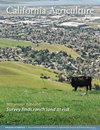二氧化硫和温度处理对红葡萄褐斑病的控制研究
IF 1.1
4区 农林科学
Q2 AGRICULTURE, MULTIDISCIPLINARY
引用次数: 1
摘要
褐斑病是一种葡萄采后病害,由加利福尼亚州圣华金谷的枝孢菌引起。它在冷藏和运输过程中传播,给主要出口到中国和墨西哥等国的晚熟葡萄品种带来了严重的经济损失。我们研究了温度和二氧化硫(SO2)处理对三种枝孢菌(Cladosporium ramotenellum,C.cladosporioides和C.limoniforme)对红球浆果真菌生长和感染的影响。红地球仪在出口方面特别受欢迎。在−2°C下储存的培养皿中,在马铃薯葡萄糖琼脂上生长的真菌菌落生长速度慢于在2°C储存的菌落,400 ppm-h的SO2处理显著降低了所有三个物种和所有测试温度下的真菌生长。用枝孢菌接种的红球浆果,用浓度为100 ppm-h、200 ppm-h和400 ppm-h的SO2处理,并在2°C的高相对湿度室中孵育28至32天,其发病率很低。对所有测试的枝孢属物种,用200 ppm-h的SO2处理可以完全防止浆果上的褐色斑点的形成。本文章由计算机程序翻译,如有差异,请以英文原文为准。
Brown spot in table grape Redglobe controlled in study with sulfur dioxide and temperature treatments
Brown spot is a postharvest disease of grapes caused by Cladosporium species in the San Joaquin Valley of California. It spreads during cold storage and transport, resulting in severe economic losses to late table grape cultivars, which are grown mainly for export to countries such as China and Mexico. We examined the effect of temperature and sulfur dioxide (SO2) treatments on fungal growth and infection of Redglobe berries by three Cladosporium species: Cladosporium ramotenellum, C. cladosporioides and C. limoniforme. Redglobe is especially popular for export. Fungal colonies growing on potato dextrose agar in petri plates stored at −2°C grew slower than those stored at 2°C, and an 400 ppm-h SO2 treatment significantly reduced fungal growth of all three species and at all temperatures tested. Redglobe berries inoculated with the Cladosporium species, treated with SO2 concentrations of 100 ppm-h, 200 ppm-h and 400 ppm-h and incubated in high relative humidity chambers for 28 to 32 days at 2°C, showed little incidence of disease. The development of brown spot on berries was entirely prevented with the treatment of 200 ppm-h SO2 for all Cladosporium species tested.
求助全文
通过发布文献求助,成功后即可免费获取论文全文。
去求助
来源期刊

California Agriculture
农林科学-农业综合
CiteScore
2.40
自引率
7.70%
发文量
17
审稿时长
>12 weeks
期刊介绍:
Information not localized
 求助内容:
求助内容: 应助结果提醒方式:
应助结果提醒方式:


